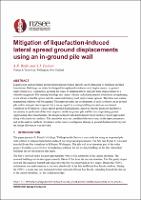| dc.contributor.author | Rolfe, Anthony | |
| dc.contributor.author | Palmer, Stuart | |
| dc.date.accessioned | 2023-08-28T04:23:30Z | |
| dc.date.available | 2023-08-28T04:23:30Z | |
| dc.date.issued | 2023-04-19 | |
| dc.identifier.uri | https://repo.nzsee.org.nz/xmlui/handle/nzsee/2598 | |
| dc.description.abstract | Liquefaction-induced lateral spread ground displacements can be damaging to buildings and their foundations. Buildings can either be designed/strengthened to tolerate such displacements, or ground improvement (e.g. compaction, grouting etc.) may be implemented to mitigate these displacements to a tolerable magnitude. For existing buildings that cannot tolerate such displacements, foundation strengthening is not always a feasible option and site constraints limit ground improvement options, therefore requiring a non-routine engineering solution. This paper presents the development of such a solution (an in-ground pile wall to mitigate lateral spread) for a site occupied by existing buildings located on a reclaimed waterfront in Wellington. Lateral spread ground displacements cannot be reliably predicted and there is uncertainty in prediction of the loads imposed on the in-ground pile wall by lateral spreading ground. Appreciating these uncertainties, the design included both displacement-based and force-based approaches along with sensitivity analysis. The sensitivity analysis considered both the uncertainty of the input parameters and resilience in the event of earthquake shaking or ground displacements beyond the ultimate limit state design allowances. | |
| dc.language.iso | en | |
| dc.publisher | New Zealand Society for Earthquake Engineering | |
| dc.relation.ispartofseries | 2023;14 | |
| dc.subject | Achieving resilience while accounting for uncertainties | |
| dc.title | Mitigation of liquefaction-induced lateral spread ground displacements using an in-ground pile wall | |
| dc.type | Article | |

